Harvesting Wild Rice: The Poetry + The Process
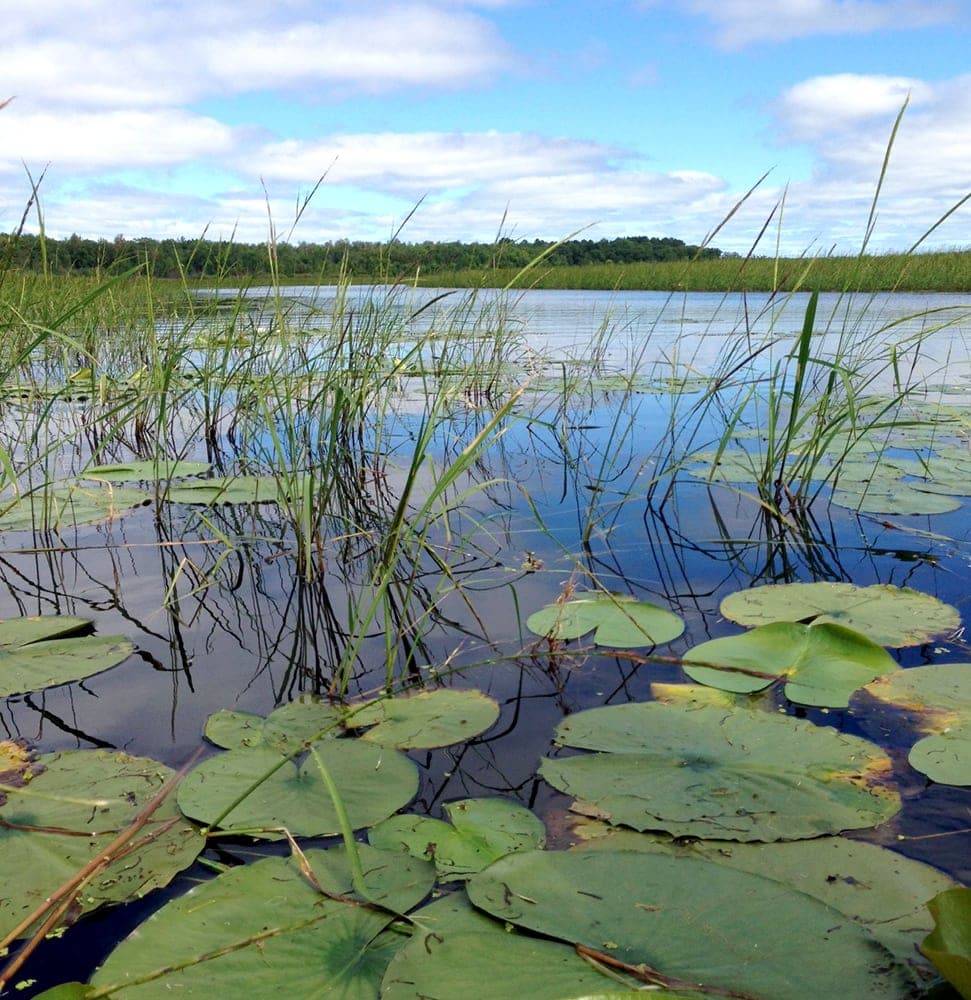
The Initial Daydream
This August I fulfilled a long haunting dream of mine – to harvest rice in the wild beds of Minnesota. The idea began as a simple seed in my early twenties. I was idealistic, entranced with the world and still exploring the ideas of living close to the land, harvesting the natural nourishment around us. I was in college and devouring land-based literature of all kinds, including a healthy stack of contemporary indigenous writers. One book in particular catapulted me into a new era of interest: Night Flying Woman by Ignatia Broker. An Anishinabe (Objibwe) elder of the Ottertail Pillager Band, Broker tells the entrancing creation tale of her matrilineal heritage from pilgrimage to work to deliverance. And at its heart, was the rice. Soon, this book, along with an influential teacher (poet and scholar) Molly McGlennen, sent me across the country to intern for a short summer month with WELRP (White Earth land Recover Project), an initiative founded by the awe-inspiring Winona Laduke. I lived in a house with a collective of native women and worked on the initiative’s farm to school project. The direct link between land and bodies, wild berries and children running along the narrow lines of the playground, entranced me. But the most bewitching of all, was the rice.
I remember when the time came on the reservation to pick lottery numbers for the best ricing lakes. I was days away from leaving, and the parting felt almost painful. Someday, I vowed to myself, I would return during ricing season. Explore the slow ponder of a boat, part the thick waves of rice and paddle silently into the deep beds. This year, that possibility became a reality.

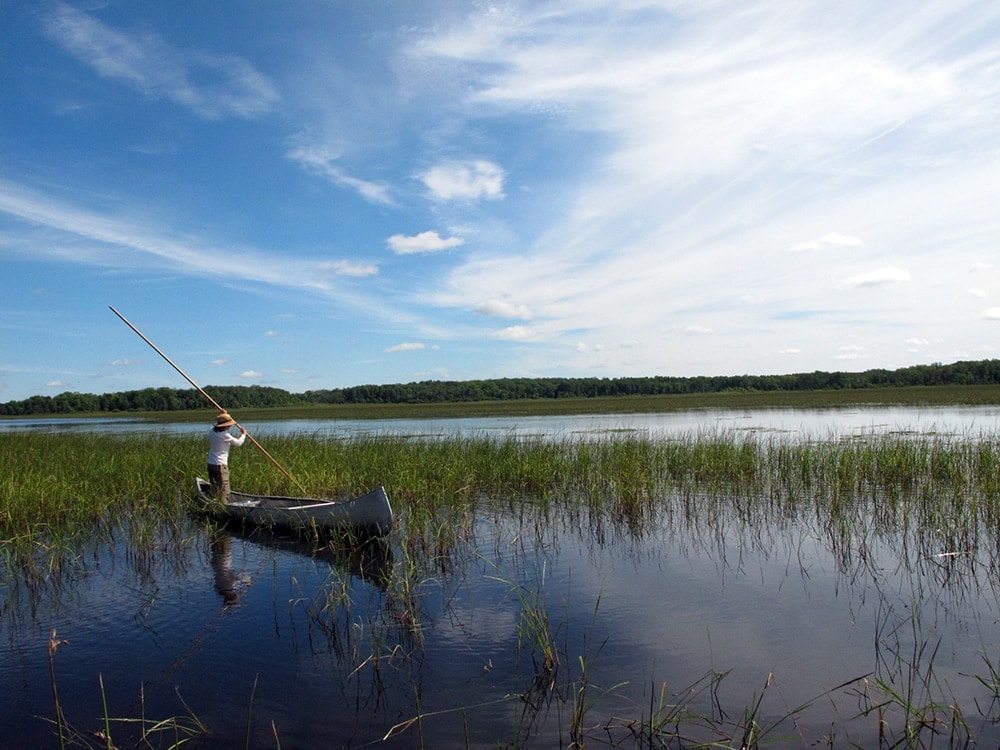
The Harvesting
The wild rice itself (Zizania palustris) is one of the most elegant plants I have ever encountered. Suspended gently in the silty mud at the bottom of the lake, each stalk sways strongly in the passing breeze. It covers the low lake, skirting the shallow shores of mud and cattails, old beaver paths and fallen logs. It is food, habitat, home. They provide shelter for the sweet and matronly mud ducks and an underbelly of fish hidden in the tea-colored water. Some stands are sparse, like grass at the edge of a long stretch of stand, and some so thick your boat runs aground onto the flattened stalks and is stuck in their woven arms. Sitting within a canoe in the middle of a dense bed feels tantamount to being lost in a graceful, fertile maze. There is nothing before you and nothing behind you, but the rice and its falling.
The act of ricing, or gathering the ripe seed of the wild rice, requires some equipment and a good deal of practiced skill. At the outset, you will need a canoe, a pair of “knockers”— tapered wands carved smooth and easy to handle, and a long pole (upwards of 17 feet) either forked or attached to a “duck bill” so you can push gently along the thick bottoms. In Minnesota the knocker sits in front of the puller, her back to the effort so she can see the coming rice. It is the knocker’s job to develop a fluid rhythm, a movement that looks like conducting a rapid symphony. With one wand, you pull the rice gently into the boat, careful not to bend the stalk too hard or knock any of the ripe seed before you are ready. With the other, you lightly but swiftly run the length of the knocker along the stalk, directing the barbed rice into the boat. Side to side: bend, swipe, swish, follow through. Meanwhile, the poler balances herself at the back of the boat, pushing the silent, rice-laden barge through the green stalks. A good puller matches her pace to the skill of the knocker, keeping her in well-falling rice. A well-seasoned poler can lift up her pole from the lake’s soft bottom (a motion akin to a sailors hand over hand climb up to the crows nest) without disturbing the steady movement of the canoe, evenly placing it back into the silt for another glide farther into the bed. (If you are interested in a more in-depth ricing “How-to” check out Samuel Thayer’s incredibly informative chapter in Foragers Harvest)
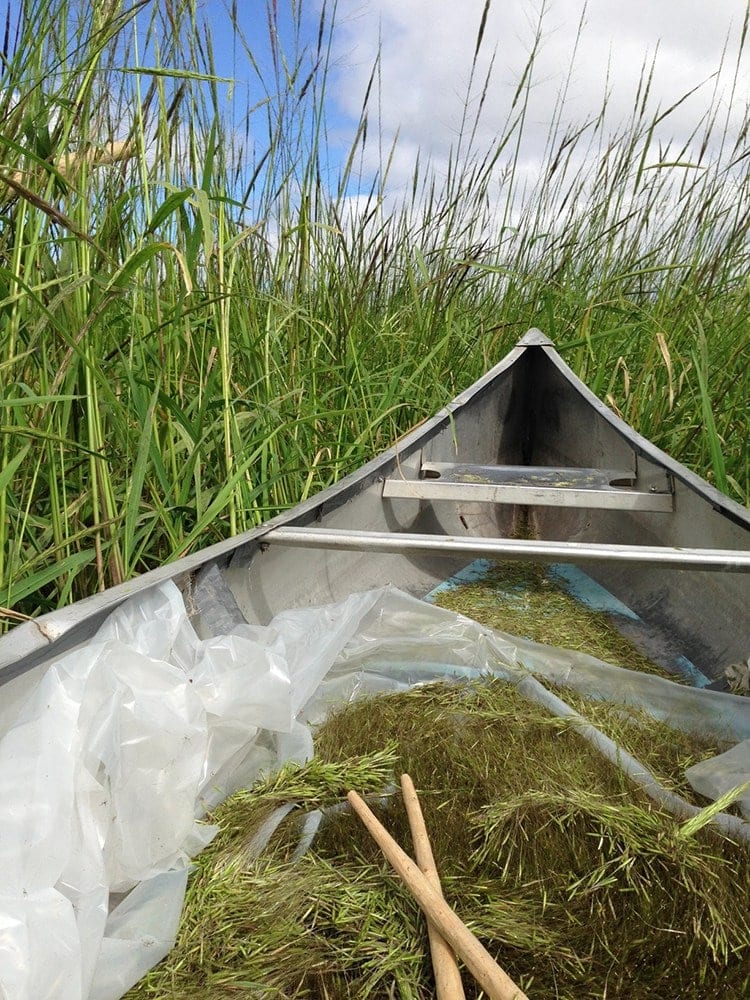
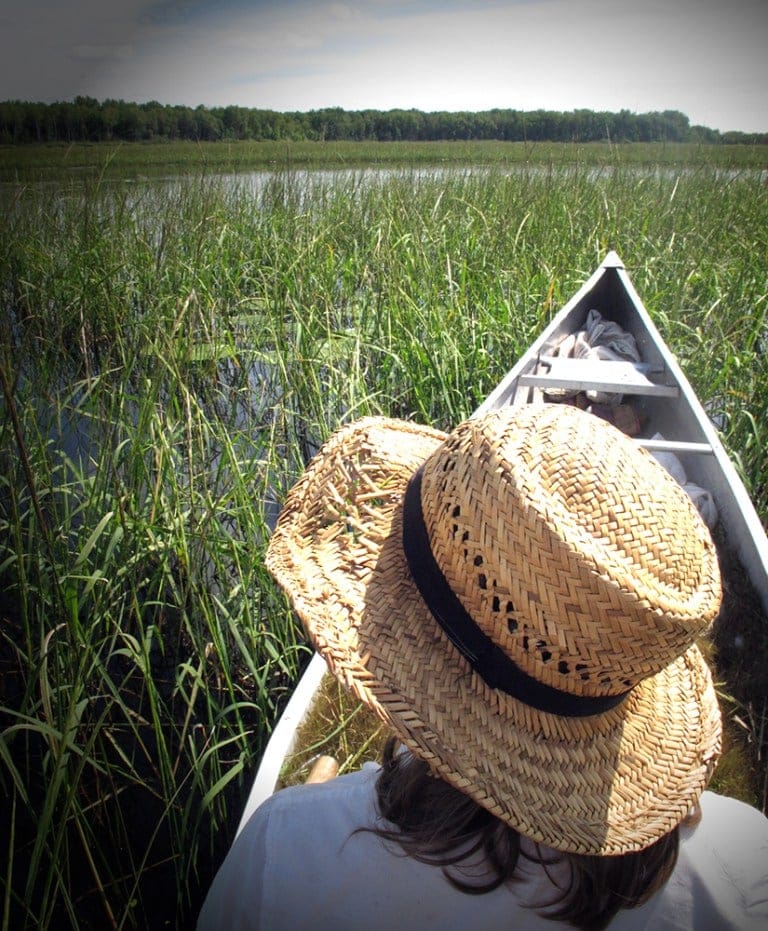
When the rice is good, it rains into the boat. Sometimes all you have to do it touch the furtive stalks and the bearded grains of purple and green fall into your palm. The act of ricing is near to addiction. Every morning we were up early, pulled out of bed by some magnetic force, pushing off the muddy landing with our lunches and cool jugs of water in tow. As a pair, you move out into the flowage and the shoulder-deep stands of rice. Once within, the forest of stalks obscures the senses. Sounds and sights seem dimmed. All you hear is the tiny, bell-shaped sounds of the rice falling into the newly empty boat, the dip of the pole in the water, the alternating absence and presence of wind.
Some days, it felt akin to prayer. All there was to ponder, to accomplish, to call in, was the rice. The intensity of the sun, the heavy water-laden pole, the long ache of our impeccably worn muscles, would fade into a rhythm. When I stood poling, I was contemplative, and soaked by the cascade. When I sat and knocked, every inch of my arms and legs, clothes and hat, was covered in the fractured beards of rice. I watched the boat grow fur as more and more of the grain piled in. Small spiders encircled the inside of the boat like garland, creating delicate trims of translucent lace. Rice worms wriggled free of the fallen grain. The landscape was a strange and teeming stillness, and within it I felt my mind itself fill with the possibility of each new stroke, a hearty and fecund fall, and the emptiness of such simple movement. Every once in a while, there was an interlude. Mud ducks scared silently from the thicket of their homes, taking to the sky in hush of quiet wings. A gust of wind strong enough to shake the stalks. The faraway hum of another boats conversation. And then, once more, silence.
The other ricers on the lake were mostly old timers – those who fell prey to the rice’s enchantment long, long ago. For these ricers, the few weeks of good rice falling was a holiday for which they waited all year. Many reserved their vacation days specifically for this— the lakes, the motion, the ability to harvest a whole years worth of precious grain in only a few days. Out on the flowage, you come to know something intimate of divinity, and of gifts. Here grows wild some of the most nutritious, delicious and filling grains in the world— and you can harvest it by the ton. On a good day a well-seasoned ricing team can pull in over 300 lbs of green rice. Parched, hulled and processed, this translates to at least 150 lbs of finished grain. It is not only possible, but easy, to harvest enough rice to last you an entire, nourished year.

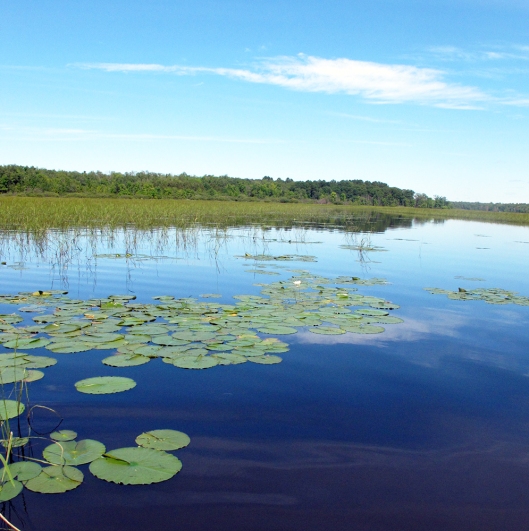
The Poetry & The Process
We camped back in a planted pine forest, alongside the flowage and next to a large meadow— ideal for drying the bounty. We bent a landing out of an old beaver path. A dark corridor of decomposing cattails and wapato (duck potato) over which we walked. It was like crawling over partially set pudding. Every few steps you’d plunge in unexpectedly, sunk up to your thighs in the thick wet humus. Pushing off in the morning was one thing…pulling a canoe laden with over a hundred pounds of rice back to shore was another. My ricing partner and I (both petite, yet tenacious women) would count to three, after which, with each gargantuan effort, we’d move the canoe forward a good six inches. At the end of a long day a swim is absolutely necessary. With thigh-high lines of pond muck and an unseen, yet supremely itchy, layer of broken “rice beards” covering your whole body—a good dip in the deep part of the flowage felt like a rich treat.


At night we cooked over an open flame: beaver and goose, bear fat and duck potatoes with wild rice and any greens that graced our camp. By the time we were all done eating, many of us shirked the pleasure of building up the fire for the comfort of our sleeping bags and a long night of sleep. For me, even in my dreams, the ricing continued. Every night, late into the night, I would awake from a dream with the high paranoia that I was still out on the lake, rocking in the small waves. A feeling like I was missing something, had somewhere yet to be. Then, the lake itself seemed to wake me up and I would remember: yes, I was allowed now to drift into other dreams and sleep. And so I would.
Harvesting was a breezy kind of labor—the variety of work that you marvel at in its making and reflect back on with pride. Processing, however, was a purer and more brutish form of drudgery. Most people these days bring their rice to a processor, and for good reason. The whole event— from start to finish— is marked by intensity, toil and, at times, extraordinary boredom. Laid out to dry in large tarps for several days, the brittle green-hulled rice in brought in grain bags to a parching station. There, it is tipped into a big metal pan, under which we build and continually feed a hot, ember rich fiber. Two stirrers sit with paddles (which we hewed from green wood) and constantly shift the rice back and forth, back and forth, walking in circles around each other and the fire. Careful not to burn the rice, parching makes the outer hull brittle and easier to remove. Parching also lends the rice a secret, smoky scent, a taste that far succeeds any spices or salt. Once properly parched, a process that usually takes about 45 minutes, the hot rice is brought over to the dancing pits.
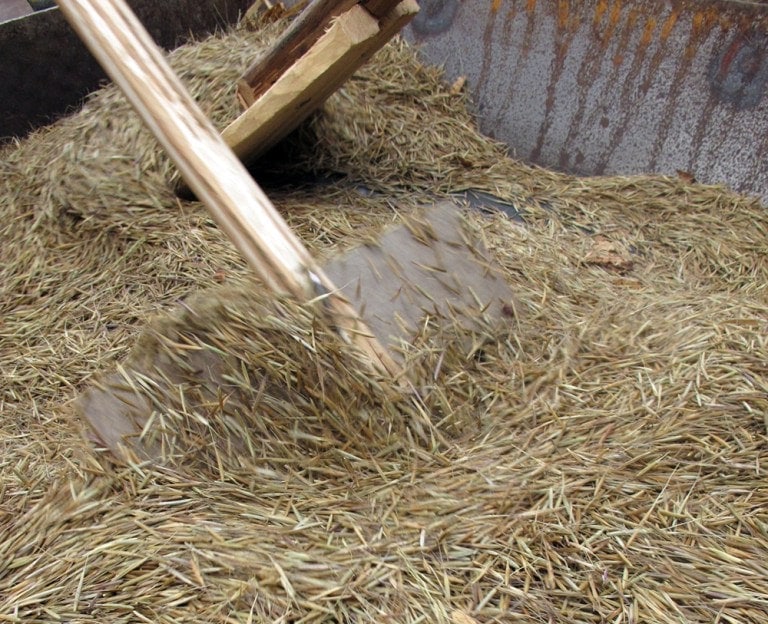

The pits themselves are dug and lined with thick hides: in this case we used elk and moose. We constructed a kind of frame around each pit, so the dancers would have poles onto which they could bare their weight. Each dancer laces themselves into buckskin booties and then lowers themselves into a scalding pit of rice. The dancing, or jigging, which sounds so sweet and stoic is actually more of a prolonged cardio workout consisting of one repetitive motion. The goal is to grind the chaff from the grain—pulverize it. And so you jig in a motion that looks like Elvis on an elliptical. Over and over. The faster you jig, the easier it will be because the heat makes the chaff give way. As the outer barbs turn to crumble, each jigger becomes increasingly more covered with a fine layer of the itchiest dust imaginable. By the end of a days span, many of us looked like woolly mammoths or unsightly Muppets. Jigging is intense: plain and simple. By day two I could hardly walk. On day five my ricing partner blew out one of her knees. Everything hurt— your shoulders, your feet, your hands. Blisters between the toes were common and dehydration an ever-present concern. We began in mid-morning and often danced until after dark.
It took a day and a half for our troupe of ten people to parch and dance the thirty gallons of finished rice my partner and I brought in. A week later, the day I left, I stood in an open field for hours, winnowing. After the tumult of harvesting and processing, winnowing was a serene luxury. The feeling of completion was tangible, something I could taste— as the chaff billowed in the air and the finished rice fell into our buckets. A poem formed in my head: A Good Day for Winnowing. And I think it might do the process more justice than I could manage in prose—
<<<< = >>>>
A Good Day for Winnowing
First, you’ll need a wind.
Rather than seek, you’ll wait
like a young wife at empty docks
—expectant, sensory, humble.
Ignore the fickle breezes, breaths that
begin and end in the same syllable murmur.
Abide the long moments of still, deflated exhale.
For winnowing, you’ll need a straight-forward wind,
one that you can read
the direction of it like Braille on your skin.
On a good day, it doesn’t take long.
Heft the sacks of some earlier harvest
to a place cleared, cleaned by wind
and let the world separate for you
the chaff.
Take your basket to the altar, the ever-open mouth
and toss, toss, all that must be tossed
toss again
until that which has weight, falls
and that which has been crushed, spent
is whisked away.
Our lives are fed by the smallest nourishments.
A single revolutionary idea that must be freed.
So hold the empty pans, hold the separating
the separate
and pray that the wind inside of you
takes even the smallest grains away.
<<<< = >>>>
For two weeks I thought of nothing but rice, and of everything kept waiting in my life. I knocked a thousand tiny ideas into the small movements of my mind— and I allowed the possibility of a single path of nourishment to unfold in the marsh. I walked in circles and I danced, I forgot what it felt like to dip my hands in hot water and remembered how to read the direction of the wind on my skin. Every repetition, repeated, was something new. From the lake, I drove—my car heavy with many gallons of rice and my heart light as butter. Ready, I felt, to allow that which has weight to fall and that which is spent to stay behind… in the soil of the fields, the surface of the water, the moments of time crushed, exhilarating, crude. The toil, already forgotten, the food of a new year replete and ready to be served.




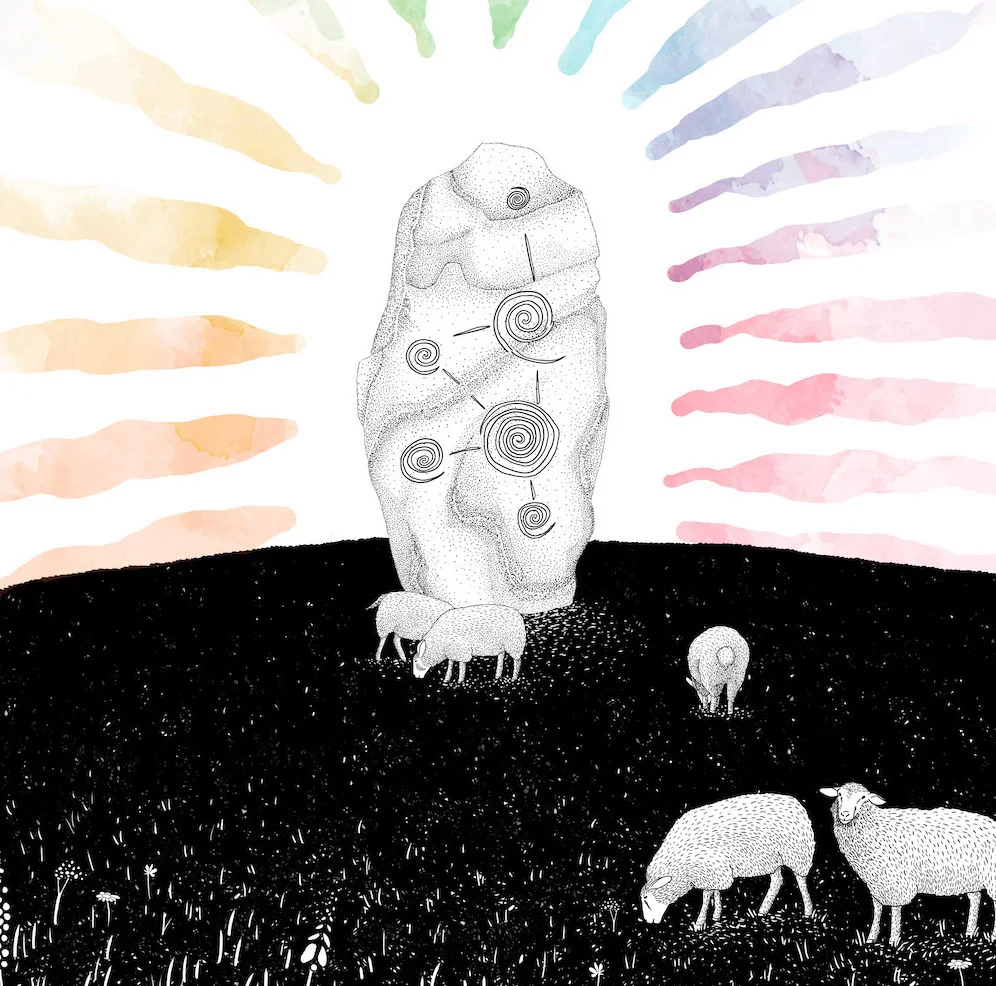
I gathered, knocked, poled, danced, itched and winnowed to your words…very captivating and beautifully written!
Now if only you could share a nice pot of cooked rice to them as well!!! Thank you kindly for such sweet words <3
Oh Asia, all of this is so so so heavenly. Taking all this in slowly; all this beauty.
Thank you dear Cristina!
Asia, thank you so much for sharing some of this precious harvest with me! I treasure the gift of nourishment and have been savoring it + sharing it. <3
Thank you for welcoming me into the apothecary and your hummingbird’s nest! It was a delight to finally meet
I encourage you to keep writing and sharing your life explorations–you have a delicate way of opening the moment for the inspiration of others.
For your personal edification, you might enjoy comparing harvesting techniques. Being out with the Natives from Wisconsin, Minnesota, and Michigan, I came to realize that some of my assumptions on how to do things were purely cultural–I needed to listen more to the rice.
Carry on!
Thank you for your sweet encouragement and supremely kind words. I am also grateful for the reminder to just listen to this beautiful plant. The people I riced with were a bit… Ahem… purest about their particular style of ricing. It’s a welcome reminder that there are many ways to enter into the same relationship with a divine. Thank you!
I echo these sentiments . . . keep writing. i am truly inspired. ‘listening to the rice’ while scooting by on the canoe conjures up some wonderful images. i hope to embark on the ricing journey at some point.
Thank you John <3 Your kind words are much appreciated
“Some days, it felt akin to prayer.” Great place to be. I enjoyed reading this piece & seeing the process. Stunning.
Thanks for reading Rick. Always an honor to have you comment!
Spectacular post full of beautifully woven images, sharing!
Thank you kindly!!
Simply beautiful, Asia. Thank you for sharing!
Thank you Bonnie!
Your writing is raw and wild, delicate and dreamy….so much voluptuous nourishment falling steady and thick, while bits of wild enchantment go spinning by, it’s quite hypnotic! Thank you, Asia…Wild rice now holds a mystical allure for me!
<3
Wow, spectacular storytelling and photos that brings the whole beautiful process to life!… and what an intense “workout” to boot!… I can’t wait to taste that rice…